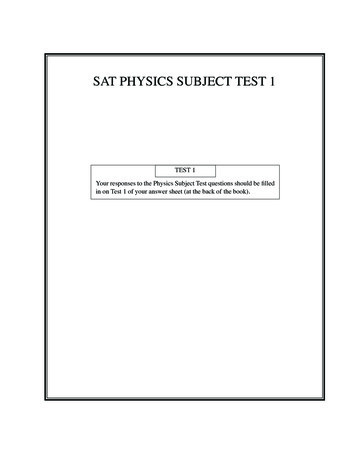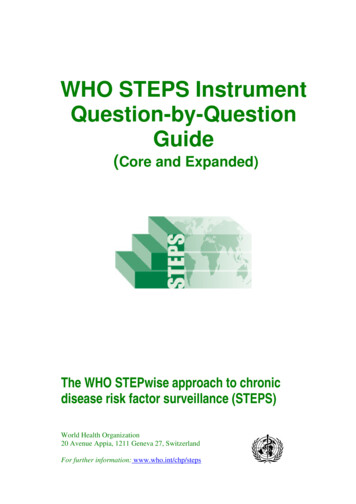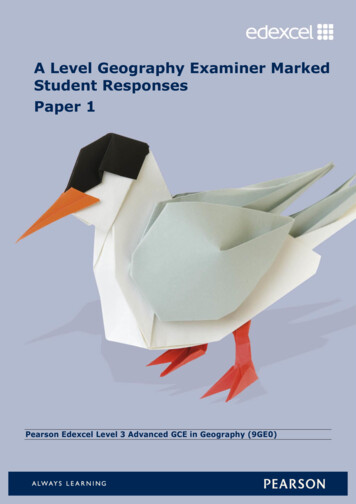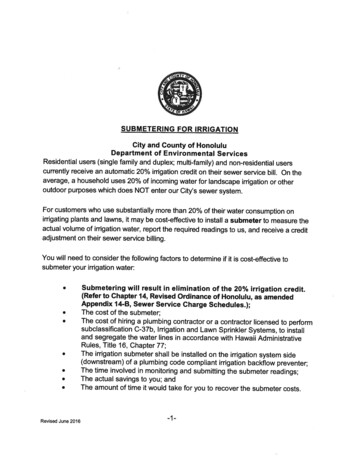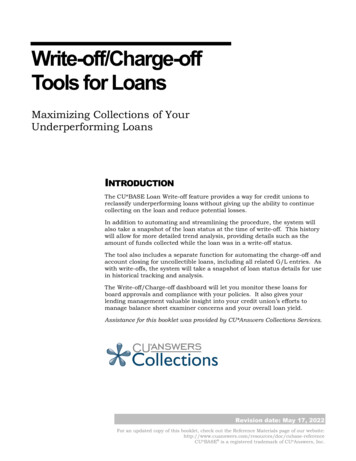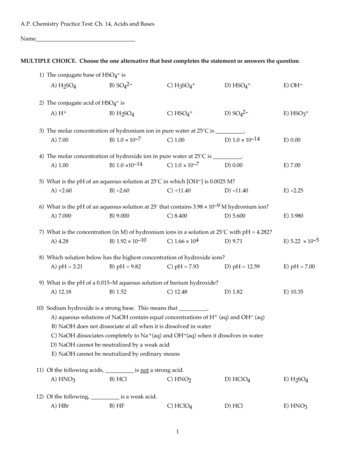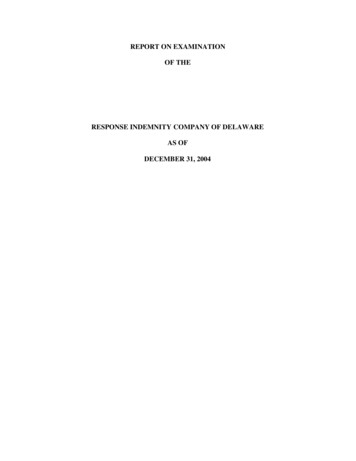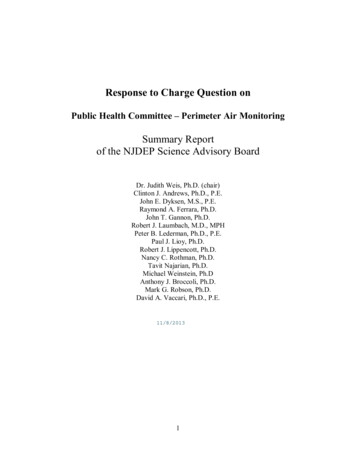
Transcription
Response to Charge Question onPublic Health Committee – Perimeter Air MonitoringSummary Reportof the NJDEP Science Advisory BoardDr. Judith Weis, Ph.D. (chair)Clinton J. Andrews, Ph.D., P.E.John E. Dyksen, M.S., P.E.Raymond A. Ferrara, Ph.D.John T. Gannon, Ph.D.Robert J. Laumbach, M.D., MPHPeter B. Lederman, Ph.D., P.E.Paul J. Lioy, Ph.D.Robert J. Lippencott, Ph.D.Nancy C. Rothman, Ph.D.Tavit Najarian, Ph.D.Michael Weinstein, Ph.DAnthony J. Broccoli, Ph.D.Mark G. Robson, Ph.D.David A. Vaccari, Ph.D., P.E.11/8/20131
NJDEP-Science Advisory Board, Public Health Standing Committee, Report on thePerimeter Air Monitoring (PAM) Charge Questions.IntroductionNew Jersey Department of Environmental Protection (NJDEP) Commissioner, BobMartin charged the Public Health Standing Committee (henceforth, “the Committee”) ofthe NJDEP Science Advisory Board (NJDEP-SAB) with three broad categories of chargequestions. The first of these, dealing with Acute Soil Exposure Criteria, was reported outto the full NJDEP-SAB which approved the recommendations of the Committee inMarch of 2012. The Committee subsequently began work on the second category ofcharge questions dealing with perimeter air monitoring (PAM) at hazardous siteremediations. These charge questions were formulated by the NJDEP’s Site RemediationProgram (SRP) in order to assist them with ensuring that remedial operations at such sitesdid not adversely impact the off-site, surrounding community. Note that these chargequestions do not deal with on-site exposure to workersThe Committee Chair, Dr. Mark Robson, appointed a PAM Workgroup (henceforth, “theWorkgroup”) to assess these charge questions. The Workgroup consisted of thefollowing Committee members:Dr. Mark Maddaloni (USEPA, Region 2), Workgroup ChairDr. Howard Kipen (UMDNJ/EOHSI)Dr. Clifford Weisel (UMDNJ/EOHSI)Jerry Kennedy (DuPont)The following NJDEP staff assisted the Workgroup:Dr. Alan Stern (Office of Science), liaison to the CommitteeDr. Terry Sugihara (SRP)Allan Motter (SRP)Workgroup meetingsThe Workgroup held eight meetings, 4/24/12, 6/4/12, 8/14/12, 10/29/12, 11/8/12,12/20/12, 1/31/13, and 3/6/13. The first two of these were face-to-face meetings atNJDEP and EOHSI, respectively. All other meetings were teleconferences.2
Background to the Workgroup’s DeliberationsSRP informed the Workgroup that the overarching scenario to be addressed under thePerimeter Air Monitoring (PAM) charge questions is the escape of contaminants from asite that is undergoing remediation. The contaminants can be soil-based or structurebased (i.e., generated from the demolition of a building). It was pointed out the thatdemolition of the Deutsche Bank building in lower Manhattan in conjunction with theWorld Trade Center collapse is an example of the latter scenario(http://www.epa.gov/wtc/demolish deconstruct/130liberty.htm). SRP further clarifiedthat PAM considerations relate to off-site air exposure and do not relate to on-site worker(occupational) exposure. Occupational exposure is addressed under OSHA regulations.With respect to the actual implementation of the Workgroup’s guidance relating to thecharge questions below, the Workgroup recognizes that its role is advisory. TheWorkgroup also recognizes that the feasibility of implementing its recommendationsdepends on practical considerations that may be outside its purview.Approval of the Workgroup Report by the Full Public Health Standing CommitteeThe Standing Public Health Committee of the NJDEP SAB met on 6/24/13 to considerthe Workgroup’s report having previously received the report for review. The followingCommittee members were present:Dr. Mark Robson (Committee Chair)Dr. Mark Maddaloni (Workgroup Chair)Dr. Steven MarcusDr. Clifford WeiselDr. Judith KlotzDr. Judith ZelikoffDr. Howard KippenThe Committee members considered the Workgroup’s recommended responses to eachof the charge questions separately and with minor editorial and clarifying changes,unanimously approved the report. The following reflects the changes requested by theComnittee.Charge QuestionsFollowing the broad PAM charge question approved by Commissioner Martin, SRP, inconsultation with the Office of Science, formulated 10 categories of specific questions.These questions are presented in detail with introductory material provided by SRP in3
Appendix I to this report. These questions reflect the draft approach, as set forth in “PAMGuidance” previously developed by SRP. The draft PAM Guidance document isattached as Appendix II. In general, the Workgroup was asked to provide its opinion andguidance relative to the draft SRP approach rather than to formulate a PAM approach denovo.Each charge question is presented below followed a summary of the discussion of theWorkgroup relative to the question and the conclusion of the Workgroup. There was nosignificant disagreement among the Workgroup members on any of their responses to thecharge questions. The conclusions and recommendations presented below thus representthe consensus of the Workgroup.Conclusions and recommendations of the Workgroup are presented in bold type.Charge Question #1 1a. Is limiting PAM to those projects of more than 30 days (with statedexceptions) defensible?In its draft guidance, SRP proposed that requirements for PAM should apply whenexposure can occur for greater than 30 days, but less than 1 year. SRP explained that itconsiders exposures resulting from site remediation of less than 30 days to be of minimalimpact and that the cumulative exposure potential for exposures of less than 30 days will,in general, not be of concern for health. However, in targeted cases exposures of lessthan 30 days may be addressed. Thus, for periods of less than 30 days it is assumed thatacute exposure guidelines (e.g., USEPA Provisional Advisory Levels (PALS) (Adeshinaet al, 2009), and Acute Exposure Guideline Levels (AEGLs)(http://www.epa.gov/oppt/aegl/) , would be used. SRP further clarified that the periodencompassed by PAM corresponds to a period(s) of active remediation resulting in soildisturbance and active emission of contaminants. PAM would not apply to a quiescentsite or a site prior to the commencement of remediation.Workgroup members suggested that the size of the remediation effort may be morerelevant for exposure impact than the duration of exposure. SRP responded that largesize remediations generally correspond to remediations that occur over greater than 30days. The Workgroup concluded that the potential exposure impact of a given siteremediation depends on the time/duration of the work, the volume of material that isremoved, the presence of sensitive receptors and the nature of the chemical contaminantsinvolved.4
The Workgroup agreed that for remediatons lasting less than 30 days, the need forPAM should not necessarily be excluded. However, the Workgroup recommendedleaving this issue for further development by SRP including the development of achecklist for initiating PAM in remediations anticipated to last less than 30 days.The Workgroup agreed that, with the exception of the less than 30 day durationchecklist suggested above, the use of PAM for intermediate (i.e., greater than 30 andless than one year) duration remediations is appropriate. 1b. Is it appropriate to consider projects with durations of 30 days or more, butless than one year as non-chronic or short-term?The workgroup interpreted this question as specifically raising the issue of whetherchronic exposure standards/guidelines (e.g, an EPA RfC (http://www.epa.gov/IRIS/) , oran ATSDR chronic MRL (http://www.atsdr.cdc.gov/toxprofiles/index.asp ) should beapplied to PAM at remediation operations of greater than 30 days, but less than one yearwhen subchronic or intermediate exposure criteria/guidelines do not exist.The Workgroup agreed that where subchronic or intermediate duration criteria exist, theycan be applied for PAM. However, where no non-chronic criteria exist, the appropriatequestion that needs to be addressed is whether to apply a chronic value with durationadjustment (i.e.- In such cases, should a chronic exposure value be adjusted upward toallow for greater exposure than would be received during a chronic exposure?).The Workgroup noted that for the Acute Soil Criteria SAB issue, the Public HealthCommittee decided not to adjust sub-chronic guidance upward to estimate thecorresponding acute criterion. In the case of PAM, the relevant adjustment would befrom chronic to sub-chronic. The Workgroup then discussed whether being at thesedifferent points on the continuum of exposure make such upward adjustments from achronic to sub-chronic exposure more acceptable than the upward adjustment form subchronic to acute that the Public Health Committee recommended against.It was noted that technically, “chronic” exposure is defined as occurring greater than10%of a lifetime (i.e., for humans, longer than 7 years)(http://ofmpub.epa.gov/sor riesandkeywordlists/search.do;jsessionid 44!-786806064?details ) . In practice, however, exposures of longer than1year would generally trigger the application of chronic standards/guidelines by SRP.Thus, for an exposure of (e.g.) 2 months, it was suggested that the application of achronic standard/guideline would be overly stringent.5
The Workgroup recognized that some “chronic” risk-based standards/guidelines (e.g.,developmental effects) are based on effects that can occur with relatively short timeexposure. These effects are, however, used to define chronic values because thestandards and guidelines protective of such effects are also protective of effects that occurwith longer-term (truly chronic) duration exposures. In this context, it was pointed outthat for such standards and guidelines, relatively short excursions above the chronic value- less than 1 year and possible as short as 1 day - could have effects. It was further notedthat even if a chronic standard/guideline was based on a true chronic effect, a shorterterm endpoint could be the next-most sensitive effect such that a short exceedance of thechronic value could trigger the non-chronic effect. As an example of this, the Workgroupconsidered that for trichloroethylene, for example, a 10x upward adjustment of thechronic guidance to estimate an acceptable subchronic exposure level would result inexposure occurring in the range of a qualitatively different type of toxicity(developmental) than was addressed by the chronic exposure guidance.The Workgroup agreed that when there is no sub-chronic inhalation guidance andthere is sufficient information to conduct a thorough literature review to ascertainthat no short-term health effect, or adverse effect other than the critical effect wouldbe triggered by the upward adjustment, such an adjustment could be appropriate.The Workgroup then considered what the appropriate magnitude of such an upwardadjustment should be. The Workgroup discussed that the current draft USEPA RemovalManagement Level guidance that addresses exposures during time-critical removalactivities recommends using a 3x upward adjustment of chronic exposure guidance toaddress subchronic exposure.A question was raised regarding whether any upward adjustment was appropriate whenthe “chronic” exposure guidance is based on developmental effects. In such cases,although the guidance is intended to apply to chronic exposure duration, the true durationof exposure over which adverse effects could occur would be less than 1 year andpossible as short as 1 day.The Workgroup agreed that there should be a chemical specific review to supportan upward adjustment with particular emphasis on adverse effects that could occurwith a relatively short duration exposure (e.g., developmental effects), but that as astarting point, a default adjustment of 3x from a chronic exposure guidance valuewas appropriate.6
1c. Is one year an appropriate cut-off beyond which to consider health effectsonly on a long-term or chronic basis?SRP explained that 225 days represents the default exposure duration assumption for aworking year (taking weekends and vacation into account). For exposures of greater thanone year, a site-specific PAM plan addressing the entire site (contaminant andremediation equipment) would be developed. However, such a plan would not be have astrict regulatory status such as would be the case for an Air Permit.On this basis, the Workgroup agreed that a one-year cut-off is appropriate forimplementation of PAM 1d. Does the SAB identify time frames applicable to PAM which it considersmore appropriate than the ones proposed?As above, the Workgroup considered the timeframe initially proposed by SRP to beappropriate for implementation of PAM.Charge Question #2 2a. Are the RfC and URF equations used in the Draft PAM Document the mostappropriate?The Workgroup agreed that the equations as presented by SRP are standard andappropriate for application per se in PAM guidance. 2b. Is the preference for using non-carcinogenic endpoints for short termexposure valid?The Workgroup observed that the URF (cancer unit risk factor for inhalation exposures)assumes a lifetime (i.e., 70 year) exposure(http://ofmpub.epa.gov/sor riesandkeywordlists/search.do?details &glossaryName IRIS%20Glossary) . The Workgroupdiscussed the fact that cancer risk from animal studies is based on animal lifetimeexposures and that cancer risk from epidemiological studies is generally calculated froma cohort with a range of exposure durations, but nonetheless extending over decades.Given this, the Workgroup noted the lack of knowledge in how, if at all, it is appropriateto scale cancer risk based on observation from long-term exposures to exposures of lessthan one year. The Workgroup further noted that despite the ability to mathematicallyscale a lifetime exposure to a one-year exposure, such an adjustment had little or nobiological basis.7
The Workgroup therefore concluded that when appropriate non-cancer guidance isavailable for a carcinogenic chemical, it should be used in preference to the URF. 2c. When there is no non-carcinogenic reference value is adjusting theacceptable ambient air concentration based on the carcinogenic value upward toreflect a short term exposure valid?It was noted that such an upward adjustment based on cancer risk would not be anadjustment to the underlying cancer potency (the Unit Cancer Risk, UCR), but to theexposure duration parameter of 70 years.The Workgroup acknowledged that there is little or no scientific basis for estimating theless than 1 year cancer risk relative to the lifetime (i.e., 70 year) cancer risk.Nonetheless, the Workgroup acknowledged that a policy-driven adjustment of theexposure corresponding to the 1 x 10-6 cancer risk by multiplying the 70-year risk by 70to extrapolate from 70 year exposure to 1 year exposure is not contradicted by theavailable science. It was also pointed out that multiplying a 1 x 10-6 risk by 70 wouldstill result in concentration with a risk of less than 1 x 10-4 from a full 70 years ofexposure. Lifetime exposure to such a level would thus be less than the upper limit of therange of cancer risk considered acceptable in various NJDEP and USEPA applications.The Workgroup recommended that in the absence of an appropriate non-cancerguideline, the exposure corresponding to a lifetime cancer of 1 x 10-6 could bemultiplied by 70 to address exposure of one year or less, but that a rreview of theavailable toxicity data should be undertaken (notwithstanding the absence of anappropriate non-cancer guideline) to provide confidence that the resulting exposurewould not likely result in significant non-cancer risk.The Workgroup also considered whether, if, for a given chemical, there is no RfC (orinhalation MRL), but an (ingestion) RfD (or ingestion-based MRL) is available, route-toroute extrapolation could be carried out to estimate the corresponding RfC providing thatthe chemical had the appropriate characteristics (see the “U.S. EPA. 1994. Methods forDerivation of Inhalation Reference Concentrations and Application of InhalationDosimetry id 71993). Under such anapproach, the resulting estimated RfC could then be adjusted to address subchronicexposure as discussed above.A Workgroup member noted that the USEPA, in its Risk Assessment Guidance forSuperfund (RAGS), part-F (http://www.epa.gov/oswer/riskassessment/ragsf/ ) iscurrently de-emphasizing the use of route-to-route extrapolation. The Workgroupmember stated, however, that this is not an agency-wide policy. It was also noted that in8
its list of IRIS guidance documents, the USEPA continues to reference the above-cited1994 Methods for Derivation of Inhalation Reference Concentrations and Application ofInhalation Dosimetry document that specifically addresses route-to-route extrapolation.The Workgroup concurred that barring portal of entry effects or marked differencein absorption; distribution; metabolism; or excretion (ADME) between the ingestionand inhalation routes, it is preferable to derive a (non-cancer) RfC from an RfDrather than extrapolate the cancer risk upward from a 70-year exposure to a oneyear exposure. If, however, there are marked differences in ADME between theinhalation and ingestion routes of exposure, the Workgroup endorsed the upwardadjustment of the exposure corresponding to the 70-year, 1 x 10-6 cancer risk bymultiplying that exposure by 70.In light of this conclusion, the Workgroup considered what the appropriate procedureshould be if an (ingestion) RfD is being used to estimate an (inhalation) RfC by route-toroute extrapolation and the starting-point RfD incorporated an uncertainty factor (UF)adjustment to estimate the chronic NOAEL from a sub-chronic NOAEL. The uncertaintyfactor for estimating a chronic NOAEL from a subchronic NOAEL is usually adownward adjustment of the subchronic value by a factor of 3 or 10. However, the RfCthat would be derived by route-to-route extrapolation is intended to be used in asubchronic (or shorter) exposure context. Thus, should the subchronic-to-chronicuncertainty factor adjustment be removed in the route-to-route extrapolation for PAMpurposes? Removal of this UF would result in a larger permissible exposure.The Workgroup members agreed that in the interest of clarity and ease ofapplication, existing sub-chronic-to-chronic adjustments should not be removed inroute-to-route extrapolations for PAM. 2d. For the above case [i.e., applying UCR cancer risk values as the basis forPAM guidance], is applying a factor of 10 to address the uncertainty of adjustingcarcinogenic values to short-term values justifiable?The Workgroup concurred that its recommendation (with the abovementionedcaveats) to extrapolate the cancer risk for a one year exposure from the lifetimecancer risk by multiplying the permissible lifetime exposure by 70, obviates thepossible utility of dividing the UCR cancer risk by a factor of 10 to estimate the riskfrom short-term exposure to carcinogens.9
2e. Is it appropriate to calculate both volatile and particulate values for allcontaminants and choose the most conservative? If not, on what basis shouldcontaminants be considered to be volatiles or particulates for the purposes of thePAM plan?SRP clarified that this question is intended to specifically apply to semi-volatilechemicals. The question does not apply to chemicals that are strictly volatile or strictlyparticulate in nature.The Workgroup agreed that for comparison between volatiles and particulates,concentrations values should be expressed as mass/volume (e.g., µg/m3) where themass (whether on particulate or in vapor form) refers to the pure chemical and notto carrier particulates. Thus mass should reflect total mass/vol. including the massof the chemical found in all forms in air. With this approach, it would not benecessary to choose between measurement of volatiles and particulates.Charge Question #3 3a. Is assuming the upper 95% confidence interval on the mean on-site soilconcentration of the target contaminant(s) for the contaminant(s)concentration in the particulates justifiable? If not, is there an alternativecourse of action?It was clarified that this approach assumes that particulates in air arise from the on-sitesoil and that the concentration on the airborne particulates is the same as that in the soil.Thus, under this approach, measurement of the particulate (not chemical) mass canprovide an estimate of the chemical concentration in air.SRP noted that they planned to eventually move toward direct measurement ofcontaminant concentration in air rather than measured as generic particulateconcentration, and that this question thus, reflected guidance for operations in the nearterm.For the measurement of particulate concentration in air (given SRP’s presentapproach), the Workgroup concurred with approach of estimating the chemicalconcentration in airborne particulates on the basis of the upper 95% confidenceinterval on the mean chemical concentration in the on-site soil. 3b. Should dust be monitored as PM10 or PM2.5?10
The Workgroup noted that PM2.5 better reflects the portion of the particulates that can beabsorbed in the respiratory tract (Costa, 2008). However, in terms of the total particulateavailable for inhalation, confining particulate measurement to PM2.5 would underestimatethe available particulate concentration. Conversely, PM10 measurements would reflect aless biologically relevant particulate fraction, but would reflect an overall higherconcentration. Also, PM10 would reflect those particulates that might be absorbed and/orinteract with tissue in the upper airways.The Workgroup recommended that for PAM, particulate measurements should bemade for PM10 as being more protective and reflective of possible respiratoryirritation and upper respiratory tract absorption.Charge Question #4The following explanatory material is provided from Appendix 2 to clarify the context ofthis question.A 24 Hour National Ambient Air Quality Standard (NAAQS) adjusted for work daylength and New Jersey background levels is also used [under the SRP draft PAM guidance]in combination [with perimeter air sampling for particulates] for particulates. For an 8hour day, the maximum level of PM10 allowed for a site is calculated [based onadjustments for work day length and New Jersey background] as 338 µg/m3. At no timecan 338 ug/m3 plus upwind background be exceeded. (PAM Guidance, Section VI.MONITORING –Appendix 2) Is it defensible to employ the 24 Hour NAAQS adjusted only for work day length (8hours) which would be 450 ug/m3? This value is derived by using the NAAQS withoutsubtracting the worst-case measured background levels associated with the Statemonitoring data (i.e. Newark data).SRP clarified that a visible dust criterion would be used in parallel with the NAAQSderived value.The Workgroup noted that although the NAAQS standard for 011/PM-NAAQS-Hassett-Sipple.pdf ) islargely based on studies of exposure to generic particulates, urban particulates ariselargely from combustion processes (including vehicle exhaust). One Workgroup memberexpressed the opinion that the endpoints for which the NAAQS particulate standard isdesigned to be protective may not be relevant to off-site exposures resulting from siteremediation because the particulates of concern from remediation are not largelycombustion particulates, and it is not clear how remediation particulates compare to11
combustion particulates in terms of toxicity. The member added, however, that he wasnot aware of a reasonable alternative to the use of the NAAQS value as a particulatecriterion in this context.SRP explained that it is proposing to use its modified version of the NAAQS particulatestandard (338 µg/m3 PM10 adjusted to 8-hr workday and correcting for backgroundconditions) as a ceiling for particulate concentration even if all chemical-specificstandards are met. SRP presented the basis for this value as:(150 µg/m3 – 37.3 µg/m3) x (24 hr/8 hr) 338 µg/m3Where 150 µg/m3 is the NAAQS 24-hr PM10 standard; 37.3 µg/m3 is SRP’s estimate ofthe generic New Jersey background PM10 concentration; and 8 hr is the default work daylength corresponding to the off-site exposure period.SRP clarified that a visible dust criterion would be used in parallel with the NAAQSderived value.The Workgroup entertained a suggestion that instead of a value based on the NAAQS, aPM10 criterion could be based on a statistical factor – e.g., the mean background PM10 x 2SD. A further clarification of this suggestion was proposed such that the mean genericbackground assumption could be specific to urban, suburban and rural settings.However, on further discussion, the Workgroup concluded that such an approach wasessentially arbitrary and, while potentially protective, it would be more defensible toapply the NAAQS criterion even if the particulates emitted from a site had a differentetiology from those commonly found in ambient air (i.e., a combustion etiology).Furthermore, the Workgroup concluded that the role of the specific particle types in thecausation of the health effects underlying the NAAQS criterion was not well understood.Therefore, the Workgroup considered that it was appropriate to apply the NAAQScriterion to perimeter air monitoring despite the conceptual difficulty presented bythe potentially different sources of site-generated and ambient particulate.The Workgroup noted that adjustment of the NAAQS concentration to account forbackground PM at the remediation site would lower the permissible concentration of PMthat was specifically emitted from the site. That is, that adjustment of the NAAQS valueto account for background would result in more stringent site criteria.The Workgroup, nonetheless, agreed that the PM concentration corresponding tothe NAAQS standard concentration should not be adjusted for background sincethe NAAQS concentration addressed total PM levels regardless of their source.In considering adjustment of the NAAQS concentration to account for an anticipated 8-hrremediation site workday (and thus, an anticipated 8 hr duration of off-site exposure), the12
Workgroup noted that while the NAAQS PM standard, itself, is defined as a 24-hraverage concentration, the PM-associated adverse health effects underlying the NAAQSstandard were not strictly defined over a given time period. Thus, there was no way toknow the risk of exposure to 8 hrs of a PM concentration that exceeds the 24-hr averageconcentration.The Workgroup therefore concluded that the NAAQS 24-hr average PMconcentration should be applied to PAM without adjustment for an 8-hr workday.SRP stated that this would result in PAM site measurements being calculated on a 24 hrbasis with 16 hr of those measurements reflecting non-remedial (background) activities.The Workgroup noted this, but agreed that given the nature of the NAAQS criterion, itwas appropriate to average background PM concentrations with PM concentrationsmeasured during site work.In considering whether the appropriate NAAQS PM standard to apply to PAM is thePM10 or the PM2.5 standard, the Workgroup noted that the NAAQS standards for bothPM10 and PM2.5 were potentially applicable for PAM. The PM10 standard would be mostapplicable to entrainment of soil particles due soil disturbance during remediation work(e.g., digging, truck traffic), while the PM2.5 standard would be most applicable to vehicleand stationary combustion (e.g., generator) emissions.The Workgroup agreed that the PM10 would be most appropriate and useful giventhat soil disturbance would likely constitute the largest part of total PM emissions.This conclusion is consistent with the Workgroup’s previous determination that PMmeasurements for PAM should be made as PM10.Charge Question #5 5a. Is it appropriate to allow screening of volatile contaminants as totalvolatiles? Should it be mandatory to employ an instrument which canspeciate the contaminants (i.e. field GC)?Underlying this question are alternate air sampling strategies that are available for PAM.One strategy uses direct reading sampling devices (i.e., photo-ionization/flame ionizationdetectors, PID/FID) that employ a common property of many volatile organic compounds– their relatively low energy ionizability in air and the ability to measure relatively lowconcentrations of the resulting ions (http://www.ert.org/products/2008.PDF) . Thisapproach has the advantage of providing an essentially real-time measure of airborneconcentration of gases and vapors. However, this approach also has the disadvantage ofmeasuring a non-chemical specific property of volatile organics. It therefore cannot13
distinguish the components of a mixture of volatile organics or identify an unknownvolatile organic that may be emitted during a remediation.A second strategy uses a field gas chromatograph (GC)(http://www.ert.org/products/2008.PDF). While not technically a real-time measurementdevice, a field-GC can provide quantitative measurements and tentative identification of arange of specific airborne chemicals within minutes to approximately one hour ofsampling. This instrument is able to provide chemical-specific quantitative informationwhen the chemical of interest is known and the instrument is calibrated to that chemical.The instrument is less useful for identification of unknown chemicals in the field,although tentative identification of unknowns based on retention time on the column ispossible. A limitation of field GCs is that for some chemicals, the detection limit mayexceed the PAM action level.A third strategy is to collect air samples over the course of a day’s site work (or somefraction of a full day’s work) and to analyze those samples in an off-site laboratory
These charge questions were formulated by the NJDEP's Site Remediation Program (SRP) in order to assist them with ensuring that remedial operations at such sites did not adversely impact the off-site, surrounding community. . SRP explained that 225 days represents the default exposure duration assumption for a working year (taking weekends .
